The Use of Ultra High Performance Concrete in Field Construction
VerifiedAdded on 2020/01/16
|10
|2854
|244
Report
AI Summary
This report delves into the application of Ultra High Performance Concrete (UHPC) in civil engineering, specifically examining its use in field construction, with a focus on bridge projects. It highlights the superior mechanical properties of UHPC, including high compressive and tensile strengths, and its advantages over conventional concrete, such as increased lifespan and reduced maintenance costs. The study analyzes the design and construction procedures of the Hawkeye Bridge system, incorporating K-UHPC technology, and discusses the logistical aspects of material transportation and installation. Furthermore, the report reviews existing literature on UHPC, including curing methods and the development of compressive strength, and presents the objectives and methodology used in the analysis of UHPC bridge systems, with results and discussions on the performance and benefits of UHPC in construction. The report concludes with a summary of the findings and emphasizes the potential of UHPC to enhance the durability and efficiency of civil infrastructure.

Running Head: DISSERTATION
The use of Ultra High Performance Concrete in the Field Construction
[Name of the Writer]
[Name of Institution]
[Date]
The use of Ultra High Performance Concrete in the Field Construction
[Name of the Writer]
[Name of Institution]
[Date]
Paraphrase This Document
Need a fresh take? Get an instant paraphrase of this document with our AI Paraphraser

Abstract
The performance of “Ultra High Performance Concrete (UHPH)” is often entails different
particles such as sand, crushed quartz and other characteristics with water viability of ratio
between 0.24 or higher. With few exceptions of mixing materials, the density of mechanics
becomes maximized as it omits it from other mixing particles as well. The addition of steel with
fibers, it raises the resilience of highly compressive and built strong relationship with tensile
strengths. The utilization of bridge by using “UHPC”, the steel becomes stronger with addition
of conventional bridge concrete system. However, “UHPC” has been designed by “Korean
Institute of Civil Engineering and Building Technology (K-UHPC)”. Previously, this institution
incorporates their business action in building bridges and suggested its name with “Hawkeye” in
one the city called Lowa. This study illustrates the design and construction procedure with the
inclusion of “Hawkeye Bridge” system used by USA in the construction of making bridges with
technology such as “(K-UHPC)”. The design of this unique technological system is proximate
with earlier designed “MIT” and later transferred it to the type of Hawkeye Bridge. This entire
system of constructing bridges in developed and under developed parts of the world incorporates
with utilization of local cement, sand and other muddy particles in order to developed bridges.
Further, the transportation of bridge making material has been recorded as 17 miles from the
actual constructing site in Buchanan country. The installation took one day to complete its
process and available to be used in finished products of bridges. The aim of making this system
of construction to minimize traffic disruption and other similar obstacles that arise in flow of
traffic.
The performance of “Ultra High Performance Concrete (UHPH)” is often entails different
particles such as sand, crushed quartz and other characteristics with water viability of ratio
between 0.24 or higher. With few exceptions of mixing materials, the density of mechanics
becomes maximized as it omits it from other mixing particles as well. The addition of steel with
fibers, it raises the resilience of highly compressive and built strong relationship with tensile
strengths. The utilization of bridge by using “UHPC”, the steel becomes stronger with addition
of conventional bridge concrete system. However, “UHPC” has been designed by “Korean
Institute of Civil Engineering and Building Technology (K-UHPC)”. Previously, this institution
incorporates their business action in building bridges and suggested its name with “Hawkeye” in
one the city called Lowa. This study illustrates the design and construction procedure with the
inclusion of “Hawkeye Bridge” system used by USA in the construction of making bridges with
technology such as “(K-UHPC)”. The design of this unique technological system is proximate
with earlier designed “MIT” and later transferred it to the type of Hawkeye Bridge. This entire
system of constructing bridges in developed and under developed parts of the world incorporates
with utilization of local cement, sand and other muddy particles in order to developed bridges.
Further, the transportation of bridge making material has been recorded as 17 miles from the
actual constructing site in Buchanan country. The installation took one day to complete its
process and available to be used in finished products of bridges. The aim of making this system
of construction to minimize traffic disruption and other similar obstacles that arise in flow of
traffic.

Table of Contents
Introduction......................................................................................................................................1
Purpose of the study.....................................................................................................................2
Research objectives......................................................................................................................2
Literature Review............................................................................................................................2
Design of experiment.......................................................................................................................3
Results and Discussions...................................................................................................................4
Conclusion.......................................................................................................................................5
References........................................................................................................................................6
Appendices......................................................................................................................................7
Introduction......................................................................................................................................1
Purpose of the study.....................................................................................................................2
Research objectives......................................................................................................................2
Literature Review............................................................................................................................2
Design of experiment.......................................................................................................................3
Results and Discussions...................................................................................................................4
Conclusion.......................................................................................................................................5
References........................................................................................................................................6
Appendices......................................................................................................................................7
⊘ This is a preview!⊘
Do you want full access?
Subscribe today to unlock all pages.

Trusted by 1+ million students worldwide
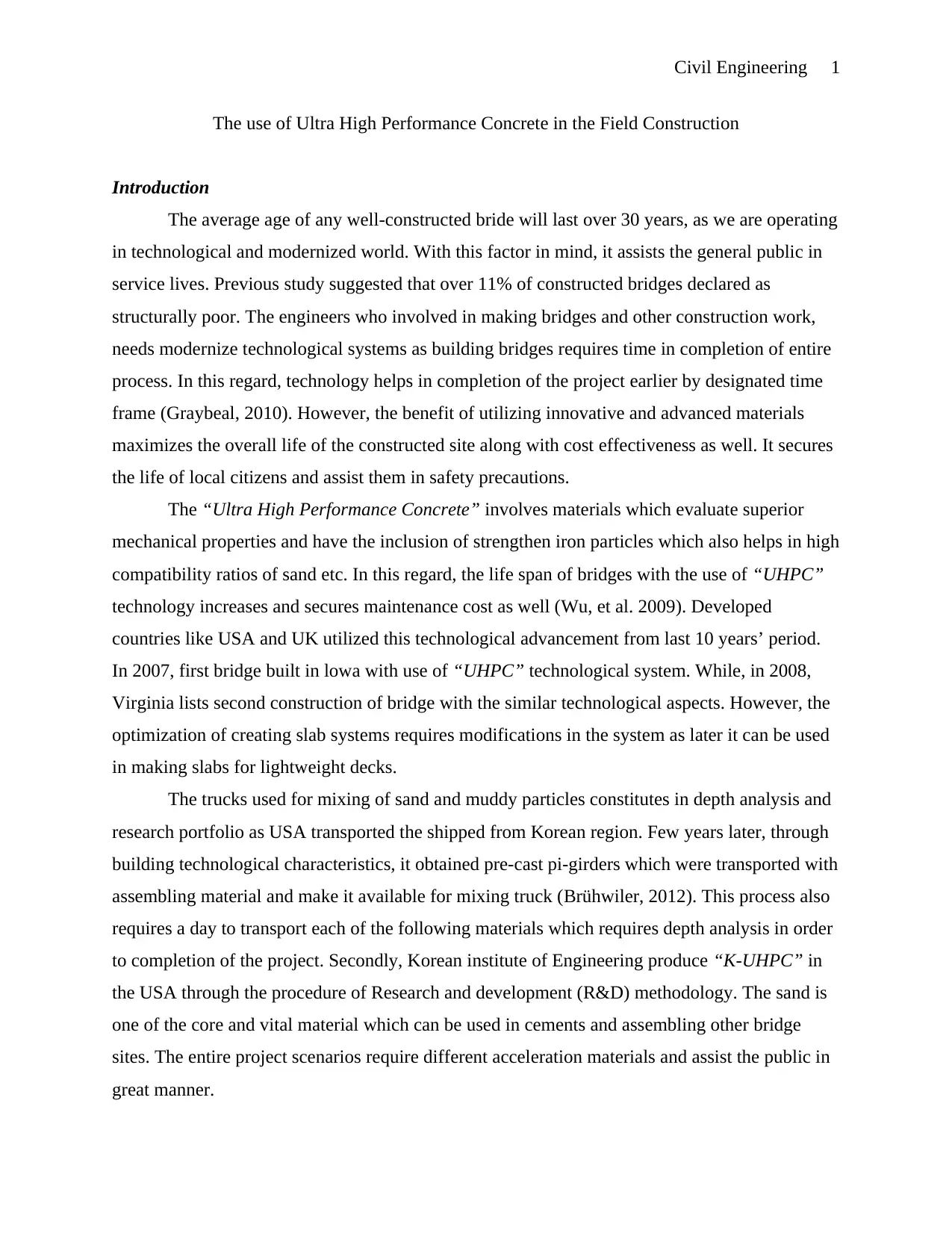
Civil Engineering 1
The use of Ultra High Performance Concrete in the Field Construction
Introduction
The average age of any well-constructed bride will last over 30 years, as we are operating
in technological and modernized world. With this factor in mind, it assists the general public in
service lives. Previous study suggested that over 11% of constructed bridges declared as
structurally poor. The engineers who involved in making bridges and other construction work,
needs modernize technological systems as building bridges requires time in completion of entire
process. In this regard, technology helps in completion of the project earlier by designated time
frame (Graybeal, 2010). However, the benefit of utilizing innovative and advanced materials
maximizes the overall life of the constructed site along with cost effectiveness as well. It secures
the life of local citizens and assist them in safety precautions.
The “Ultra High Performance Concrete” involves materials which evaluate superior
mechanical properties and have the inclusion of strengthen iron particles which also helps in high
compatibility ratios of sand etc. In this regard, the life span of bridges with the use of “UHPC”
technology increases and secures maintenance cost as well (Wu, et al. 2009). Developed
countries like USA and UK utilized this technological advancement from last 10 years’ period.
In 2007, first bridge built in lowa with use of “UHPC” technological system. While, in 2008,
Virginia lists second construction of bridge with the similar technological aspects. However, the
optimization of creating slab systems requires modifications in the system as later it can be used
in making slabs for lightweight decks.
The trucks used for mixing of sand and muddy particles constitutes in depth analysis and
research portfolio as USA transported the shipped from Korean region. Few years later, through
building technological characteristics, it obtained pre-cast pi-girders which were transported with
assembling material and make it available for mixing truck (Brühwiler, 2012). This process also
requires a day to transport each of the following materials which requires depth analysis in order
to completion of the project. Secondly, Korean institute of Engineering produce “K-UHPC” in
the USA through the procedure of Research and development (R&D) methodology. The sand is
one of the core and vital material which can be used in cements and assembling other bridge
sites. The entire project scenarios require different acceleration materials and assist the public in
great manner.
The use of Ultra High Performance Concrete in the Field Construction
Introduction
The average age of any well-constructed bride will last over 30 years, as we are operating
in technological and modernized world. With this factor in mind, it assists the general public in
service lives. Previous study suggested that over 11% of constructed bridges declared as
structurally poor. The engineers who involved in making bridges and other construction work,
needs modernize technological systems as building bridges requires time in completion of entire
process. In this regard, technology helps in completion of the project earlier by designated time
frame (Graybeal, 2010). However, the benefit of utilizing innovative and advanced materials
maximizes the overall life of the constructed site along with cost effectiveness as well. It secures
the life of local citizens and assist them in safety precautions.
The “Ultra High Performance Concrete” involves materials which evaluate superior
mechanical properties and have the inclusion of strengthen iron particles which also helps in high
compatibility ratios of sand etc. In this regard, the life span of bridges with the use of “UHPC”
technology increases and secures maintenance cost as well (Wu, et al. 2009). Developed
countries like USA and UK utilized this technological advancement from last 10 years’ period.
In 2007, first bridge built in lowa with use of “UHPC” technological system. While, in 2008,
Virginia lists second construction of bridge with the similar technological aspects. However, the
optimization of creating slab systems requires modifications in the system as later it can be used
in making slabs for lightweight decks.
The trucks used for mixing of sand and muddy particles constitutes in depth analysis and
research portfolio as USA transported the shipped from Korean region. Few years later, through
building technological characteristics, it obtained pre-cast pi-girders which were transported with
assembling material and make it available for mixing truck (Brühwiler, 2012). This process also
requires a day to transport each of the following materials which requires depth analysis in order
to completion of the project. Secondly, Korean institute of Engineering produce “K-UHPC” in
the USA through the procedure of Research and development (R&D) methodology. The sand is
one of the core and vital material which can be used in cements and assembling other bridge
sites. The entire project scenarios require different acceleration materials and assist the public in
great manner.
Paraphrase This Document
Need a fresh take? Get an instant paraphrase of this document with our AI Paraphraser
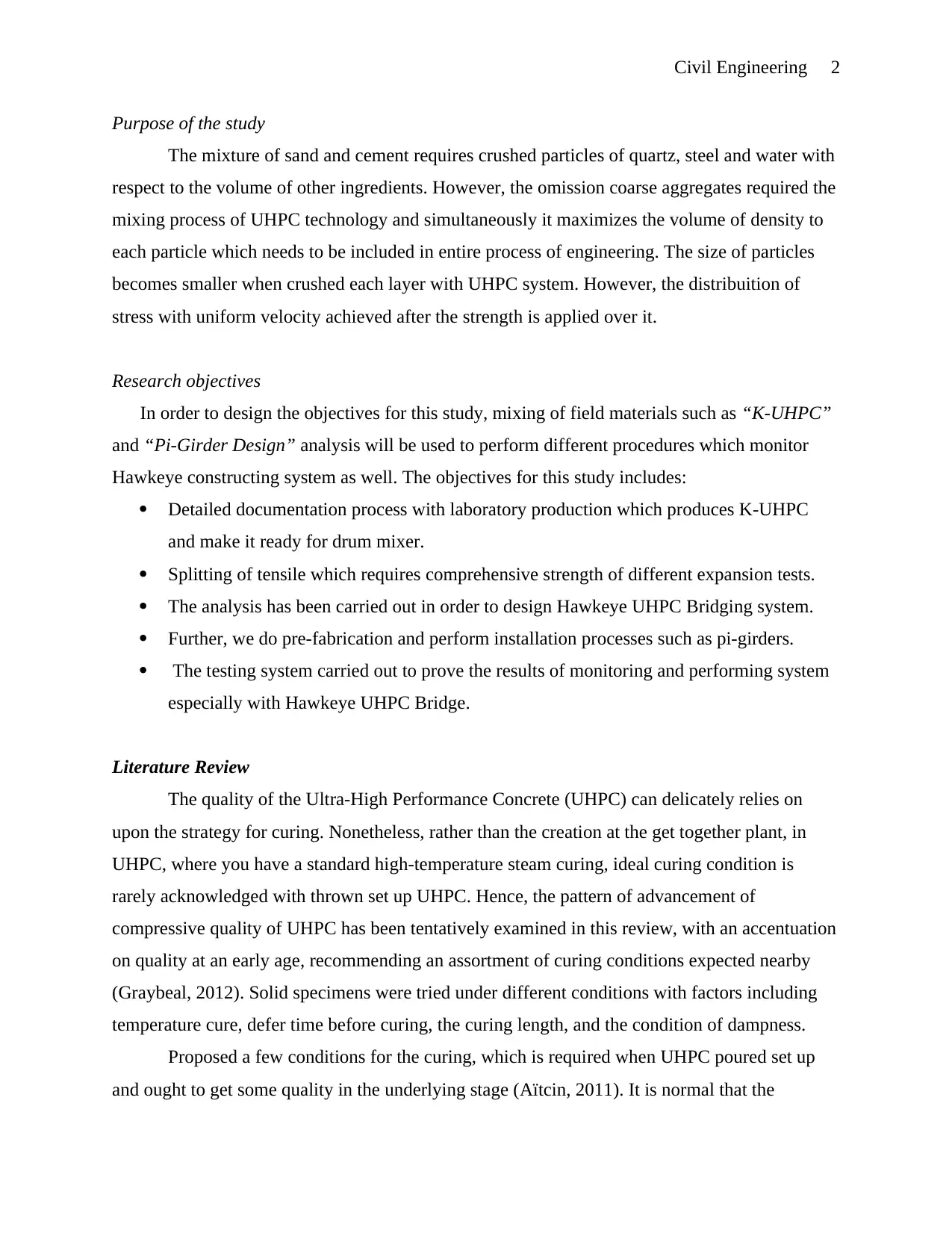
Civil Engineering 2
Purpose of the study
The mixture of sand and cement requires crushed particles of quartz, steel and water with
respect to the volume of other ingredients. However, the omission coarse aggregates required the
mixing process of UHPC technology and simultaneously it maximizes the volume of density to
each particle which needs to be included in entire process of engineering. The size of particles
becomes smaller when crushed each layer with UHPC system. However, the distribuition of
stress with uniform velocity achieved after the strength is applied over it.
Research objectives
In order to design the objectives for this study, mixing of field materials such as “K-UHPC”
and “Pi-Girder Design” analysis will be used to perform different procedures which monitor
Hawkeye constructing system as well. The objectives for this study includes:
Detailed documentation process with laboratory production which produces K-UHPC
and make it ready for drum mixer.
Splitting of tensile which requires comprehensive strength of different expansion tests.
The analysis has been carried out in order to design Hawkeye UHPC Bridging system.
Further, we do pre-fabrication and perform installation processes such as pi-girders.
The testing system carried out to prove the results of monitoring and performing system
especially with Hawkeye UHPC Bridge.
Literature Review
The quality of the Ultra-High Performance Concrete (UHPC) can delicately relies on
upon the strategy for curing. Nonetheless, rather than the creation at the get together plant, in
UHPC, where you have a standard high-temperature steam curing, ideal curing condition is
rarely acknowledged with thrown set up UHPC. Hence, the pattern of advancement of
compressive quality of UHPC has been tentatively examined in this review, with an accentuation
on quality at an early age, recommending an assortment of curing conditions expected nearby
(Graybeal, 2012). Solid specimens were tried under different conditions with factors including
temperature cure, defer time before curing, the curing length, and the condition of dampness.
Proposed a few conditions for the curing, which is required when UHPC poured set up
and ought to get some quality in the underlying stage (Aïtcin, 2011). It is normal that the
Purpose of the study
The mixture of sand and cement requires crushed particles of quartz, steel and water with
respect to the volume of other ingredients. However, the omission coarse aggregates required the
mixing process of UHPC technology and simultaneously it maximizes the volume of density to
each particle which needs to be included in entire process of engineering. The size of particles
becomes smaller when crushed each layer with UHPC system. However, the distribuition of
stress with uniform velocity achieved after the strength is applied over it.
Research objectives
In order to design the objectives for this study, mixing of field materials such as “K-UHPC”
and “Pi-Girder Design” analysis will be used to perform different procedures which monitor
Hawkeye constructing system as well. The objectives for this study includes:
Detailed documentation process with laboratory production which produces K-UHPC
and make it ready for drum mixer.
Splitting of tensile which requires comprehensive strength of different expansion tests.
The analysis has been carried out in order to design Hawkeye UHPC Bridging system.
Further, we do pre-fabrication and perform installation processes such as pi-girders.
The testing system carried out to prove the results of monitoring and performing system
especially with Hawkeye UHPC Bridge.
Literature Review
The quality of the Ultra-High Performance Concrete (UHPC) can delicately relies on
upon the strategy for curing. Nonetheless, rather than the creation at the get together plant, in
UHPC, where you have a standard high-temperature steam curing, ideal curing condition is
rarely acknowledged with thrown set up UHPC. Hence, the pattern of advancement of
compressive quality of UHPC has been tentatively examined in this review, with an accentuation
on quality at an early age, recommending an assortment of curing conditions expected nearby
(Graybeal, 2012). Solid specimens were tried under different conditions with factors including
temperature cure, defer time before curing, the curing length, and the condition of dampness.
Proposed a few conditions for the curing, which is required when UHPC poured set up
and ought to get some quality in the underlying stage (Aïtcin, 2011). It is normal that the
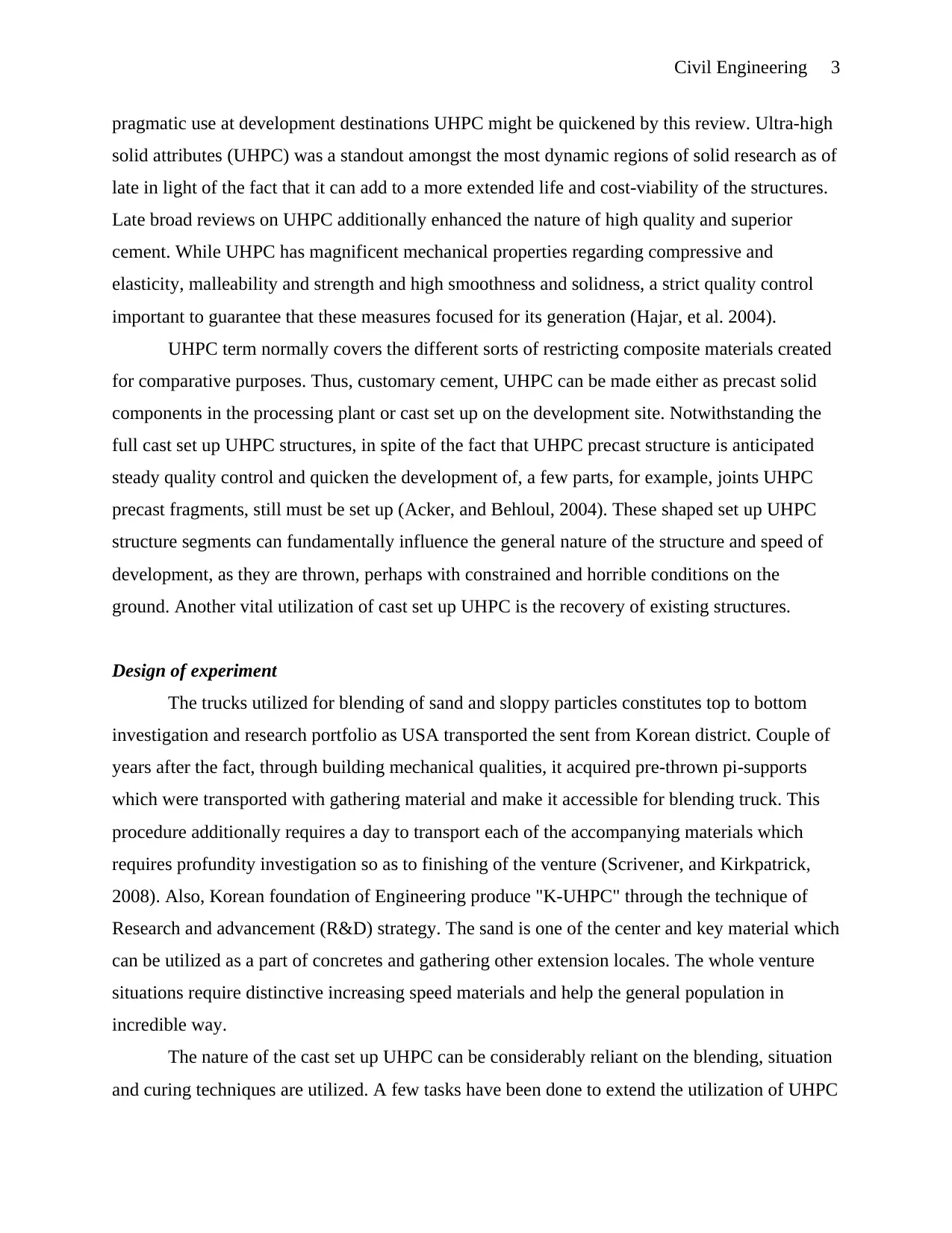
Civil Engineering 3
pragmatic use at development destinations UHPC might be quickened by this review. Ultra-high
solid attributes (UHPC) was a standout amongst the most dynamic regions of solid research as of
late in light of the fact that it can add to a more extended life and cost-viability of the structures.
Late broad reviews on UHPC additionally enhanced the nature of high quality and superior
cement. While UHPC has magnificent mechanical properties regarding compressive and
elasticity, malleability and strength and high smoothness and solidness, a strict quality control
important to guarantee that these measures focused for its generation (Hajar, et al. 2004).
UHPC term normally covers the different sorts of restricting composite materials created
for comparative purposes. Thus, customary cement, UHPC can be made either as precast solid
components in the processing plant or cast set up on the development site. Notwithstanding the
full cast set up UHPC structures, in spite of the fact that UHPC precast structure is anticipated
steady quality control and quicken the development of, a few parts, for example, joints UHPC
precast fragments, still must be set up (Acker, and Behloul, 2004). These shaped set up UHPC
structure segments can fundamentally influence the general nature of the structure and speed of
development, as they are thrown, perhaps with constrained and horrible conditions on the
ground. Another vital utilization of cast set up UHPC is the recovery of existing structures.
Design of experiment
The trucks utilized for blending of sand and sloppy particles constitutes top to bottom
investigation and research portfolio as USA transported the sent from Korean district. Couple of
years after the fact, through building mechanical qualities, it acquired pre-thrown pi-supports
which were transported with gathering material and make it accessible for blending truck. This
procedure additionally requires a day to transport each of the accompanying materials which
requires profundity investigation so as to finishing of the venture (Scrivener, and Kirkpatrick,
2008). Also, Korean foundation of Engineering produce "K-UHPC" through the technique of
Research and advancement (R&D) strategy. The sand is one of the center and key material which
can be utilized as a part of concretes and gathering other extension locales. The whole venture
situations require distinctive increasing speed materials and help the general population in
incredible way.
The nature of the cast set up UHPC can be considerably reliant on the blending, situation
and curing techniques are utilized. A few tasks have been done to extend the utilization of UHPC
pragmatic use at development destinations UHPC might be quickened by this review. Ultra-high
solid attributes (UHPC) was a standout amongst the most dynamic regions of solid research as of
late in light of the fact that it can add to a more extended life and cost-viability of the structures.
Late broad reviews on UHPC additionally enhanced the nature of high quality and superior
cement. While UHPC has magnificent mechanical properties regarding compressive and
elasticity, malleability and strength and high smoothness and solidness, a strict quality control
important to guarantee that these measures focused for its generation (Hajar, et al. 2004).
UHPC term normally covers the different sorts of restricting composite materials created
for comparative purposes. Thus, customary cement, UHPC can be made either as precast solid
components in the processing plant or cast set up on the development site. Notwithstanding the
full cast set up UHPC structures, in spite of the fact that UHPC precast structure is anticipated
steady quality control and quicken the development of, a few parts, for example, joints UHPC
precast fragments, still must be set up (Acker, and Behloul, 2004). These shaped set up UHPC
structure segments can fundamentally influence the general nature of the structure and speed of
development, as they are thrown, perhaps with constrained and horrible conditions on the
ground. Another vital utilization of cast set up UHPC is the recovery of existing structures.
Design of experiment
The trucks utilized for blending of sand and sloppy particles constitutes top to bottom
investigation and research portfolio as USA transported the sent from Korean district. Couple of
years after the fact, through building mechanical qualities, it acquired pre-thrown pi-supports
which were transported with gathering material and make it accessible for blending truck. This
procedure additionally requires a day to transport each of the accompanying materials which
requires profundity investigation so as to finishing of the venture (Scrivener, and Kirkpatrick,
2008). Also, Korean foundation of Engineering produce "K-UHPC" through the technique of
Research and advancement (R&D) strategy. The sand is one of the center and key material which
can be utilized as a part of concretes and gathering other extension locales. The whole venture
situations require distinctive increasing speed materials and help the general population in
incredible way.
The nature of the cast set up UHPC can be considerably reliant on the blending, situation
and curing techniques are utilized. A few tasks have been done to extend the utilization of UHPC
⊘ This is a preview!⊘
Do you want full access?
Subscribe today to unlock all pages.

Trusted by 1+ million students worldwide
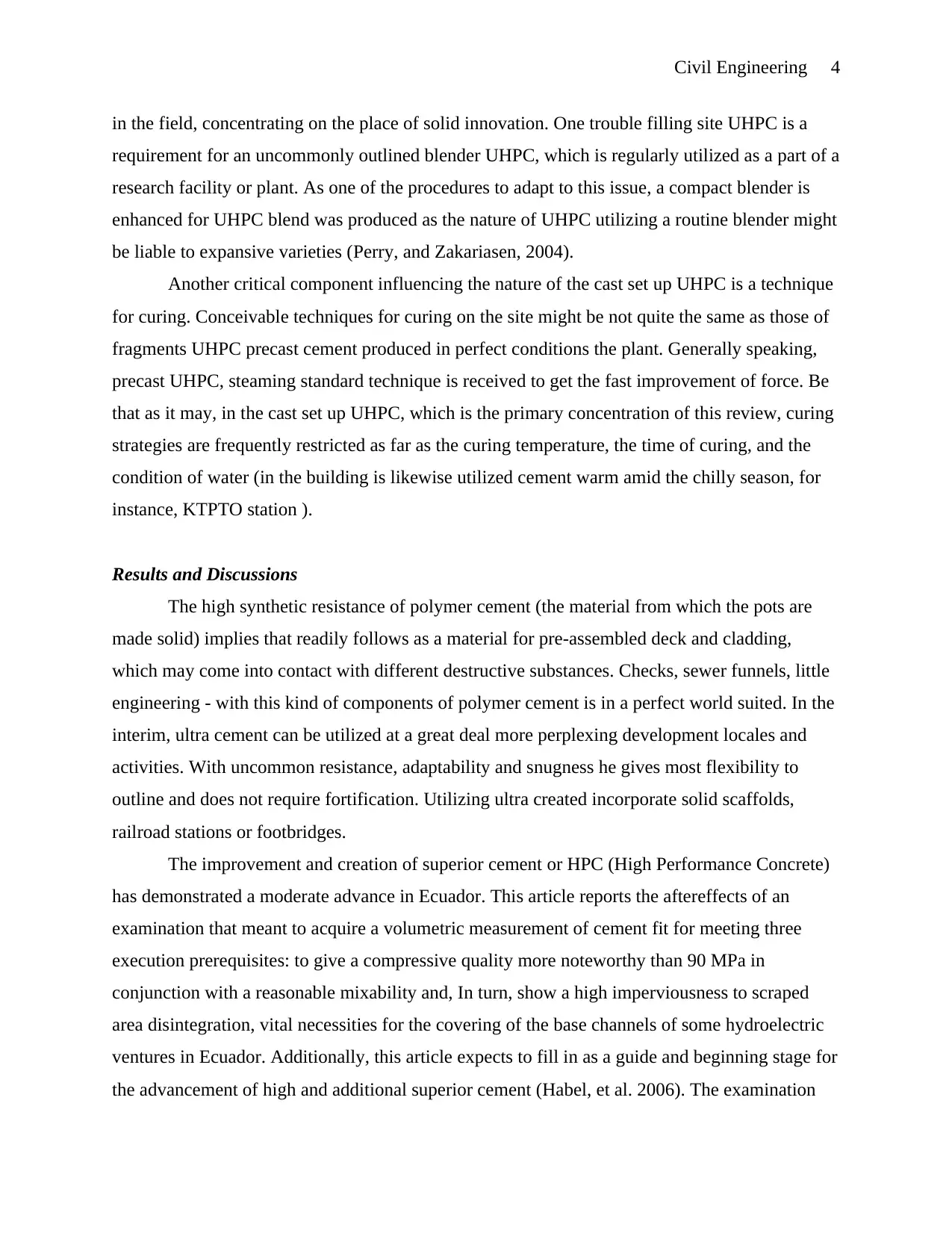
Civil Engineering 4
in the field, concentrating on the place of solid innovation. One trouble filling site UHPC is a
requirement for an uncommonly outlined blender UHPC, which is regularly utilized as a part of a
research facility or plant. As one of the procedures to adapt to this issue, a compact blender is
enhanced for UHPC blend was produced as the nature of UHPC utilizing a routine blender might
be liable to expansive varieties (Perry, and Zakariasen, 2004).
Another critical component influencing the nature of the cast set up UHPC is a technique
for curing. Conceivable techniques for curing on the site might be not quite the same as those of
fragments UHPC precast cement produced in perfect conditions the plant. Generally speaking,
precast UHPC, steaming standard technique is received to get the fast improvement of force. Be
that as it may, in the cast set up UHPC, which is the primary concentration of this review, curing
strategies are frequently restricted as far as the curing temperature, the time of curing, and the
condition of water (in the building is likewise utilized cement warm amid the chilly season, for
instance, KTPTO station ).
Results and Discussions
The high synthetic resistance of polymer cement (the material from which the pots are
made solid) implies that readily follows as a material for pre-assembled deck and cladding,
which may come into contact with different destructive substances. Checks, sewer funnels, little
engineering - with this kind of components of polymer cement is in a perfect world suited. In the
interim, ultra cement can be utilized at a great deal more perplexing development locales and
activities. With uncommon resistance, adaptability and snugness he gives most flexibility to
outline and does not require fortification. Utilizing ultra created incorporate solid scaffolds,
railroad stations or footbridges.
The improvement and creation of superior cement or HPC (High Performance Concrete)
has demonstrated a moderate advance in Ecuador. This article reports the aftereffects of an
examination that meant to acquire a volumetric measurement of cement fit for meeting three
execution prerequisites: to give a compressive quality more noteworthy than 90 MPa in
conjunction with a reasonable mixability and, In turn, show a high imperviousness to scraped
area disintegration, vital necessities for the covering of the base channels of some hydroelectric
ventures in Ecuador. Additionally, this article expects to fill in as a guide and beginning stage for
the advancement of high and additional superior cement (Habel, et al. 2006). The examination
in the field, concentrating on the place of solid innovation. One trouble filling site UHPC is a
requirement for an uncommonly outlined blender UHPC, which is regularly utilized as a part of a
research facility or plant. As one of the procedures to adapt to this issue, a compact blender is
enhanced for UHPC blend was produced as the nature of UHPC utilizing a routine blender might
be liable to expansive varieties (Perry, and Zakariasen, 2004).
Another critical component influencing the nature of the cast set up UHPC is a technique
for curing. Conceivable techniques for curing on the site might be not quite the same as those of
fragments UHPC precast cement produced in perfect conditions the plant. Generally speaking,
precast UHPC, steaming standard technique is received to get the fast improvement of force. Be
that as it may, in the cast set up UHPC, which is the primary concentration of this review, curing
strategies are frequently restricted as far as the curing temperature, the time of curing, and the
condition of water (in the building is likewise utilized cement warm amid the chilly season, for
instance, KTPTO station ).
Results and Discussions
The high synthetic resistance of polymer cement (the material from which the pots are
made solid) implies that readily follows as a material for pre-assembled deck and cladding,
which may come into contact with different destructive substances. Checks, sewer funnels, little
engineering - with this kind of components of polymer cement is in a perfect world suited. In the
interim, ultra cement can be utilized at a great deal more perplexing development locales and
activities. With uncommon resistance, adaptability and snugness he gives most flexibility to
outline and does not require fortification. Utilizing ultra created incorporate solid scaffolds,
railroad stations or footbridges.
The improvement and creation of superior cement or HPC (High Performance Concrete)
has demonstrated a moderate advance in Ecuador. This article reports the aftereffects of an
examination that meant to acquire a volumetric measurement of cement fit for meeting three
execution prerequisites: to give a compressive quality more noteworthy than 90 MPa in
conjunction with a reasonable mixability and, In turn, show a high imperviousness to scraped
area disintegration, vital necessities for the covering of the base channels of some hydroelectric
ventures in Ecuador. Additionally, this article expects to fill in as a guide and beginning stage for
the advancement of high and additional superior cement (Habel, et al. 2006). The examination
Paraphrase This Document
Need a fresh take? Get an instant paraphrase of this document with our AI Paraphraser
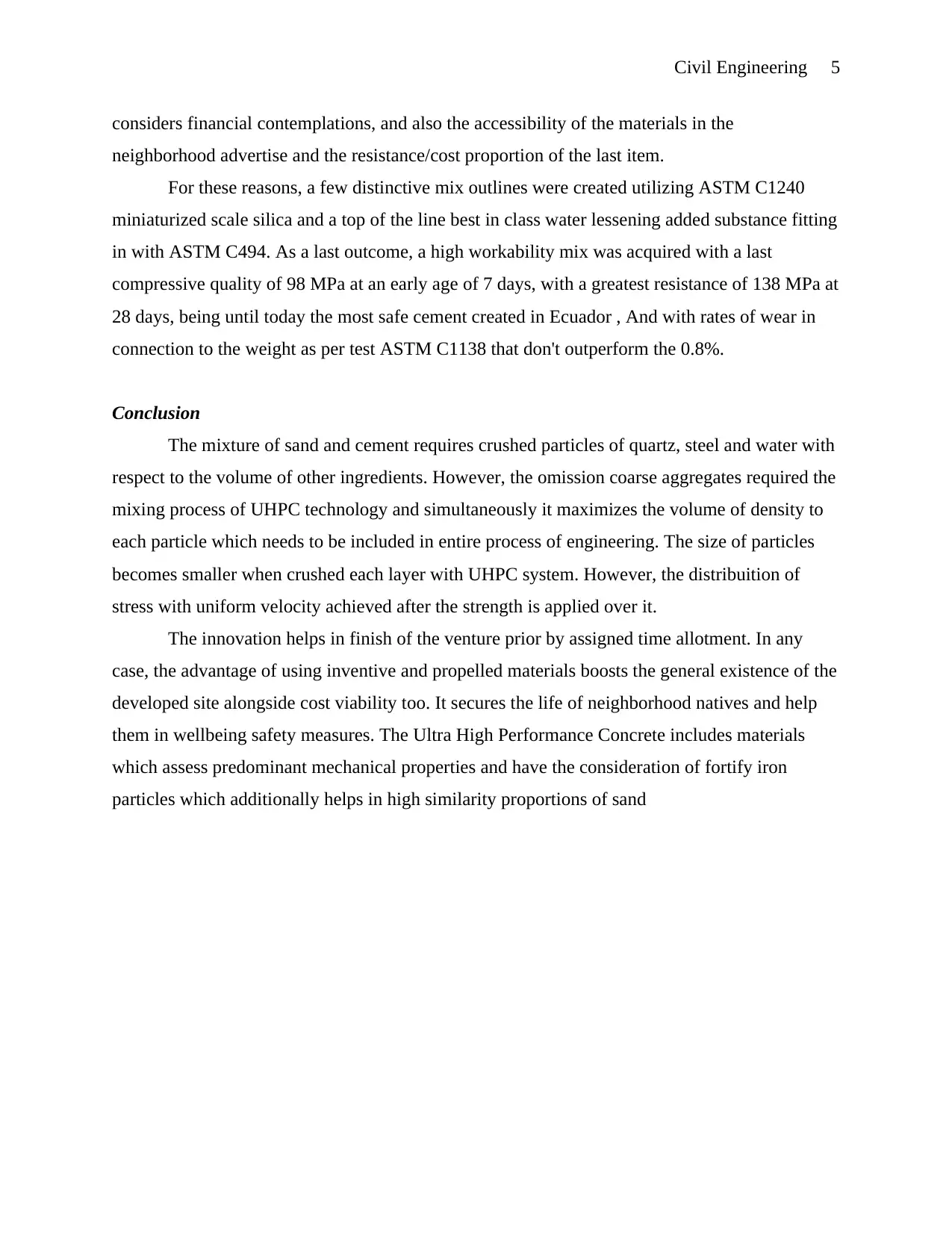
Civil Engineering 5
considers financial contemplations, and also the accessibility of the materials in the
neighborhood advertise and the resistance/cost proportion of the last item.
For these reasons, a few distinctive mix outlines were created utilizing ASTM C1240
miniaturized scale silica and a top of the line best in class water lessening added substance fitting
in with ASTM C494. As a last outcome, a high workability mix was acquired with a last
compressive quality of 98 MPa at an early age of 7 days, with a greatest resistance of 138 MPa at
28 days, being until today the most safe cement created in Ecuador , And with rates of wear in
connection to the weight as per test ASTM C1138 that don't outperform the 0.8%.
Conclusion
The mixture of sand and cement requires crushed particles of quartz, steel and water with
respect to the volume of other ingredients. However, the omission coarse aggregates required the
mixing process of UHPC technology and simultaneously it maximizes the volume of density to
each particle which needs to be included in entire process of engineering. The size of particles
becomes smaller when crushed each layer with UHPC system. However, the distribuition of
stress with uniform velocity achieved after the strength is applied over it.
The innovation helps in finish of the venture prior by assigned time allotment. In any
case, the advantage of using inventive and propelled materials boosts the general existence of the
developed site alongside cost viability too. It secures the life of neighborhood natives and help
them in wellbeing safety measures. The Ultra High Performance Concrete includes materials
which assess predominant mechanical properties and have the consideration of fortify iron
particles which additionally helps in high similarity proportions of sand
considers financial contemplations, and also the accessibility of the materials in the
neighborhood advertise and the resistance/cost proportion of the last item.
For these reasons, a few distinctive mix outlines were created utilizing ASTM C1240
miniaturized scale silica and a top of the line best in class water lessening added substance fitting
in with ASTM C494. As a last outcome, a high workability mix was acquired with a last
compressive quality of 98 MPa at an early age of 7 days, with a greatest resistance of 138 MPa at
28 days, being until today the most safe cement created in Ecuador , And with rates of wear in
connection to the weight as per test ASTM C1138 that don't outperform the 0.8%.
Conclusion
The mixture of sand and cement requires crushed particles of quartz, steel and water with
respect to the volume of other ingredients. However, the omission coarse aggregates required the
mixing process of UHPC technology and simultaneously it maximizes the volume of density to
each particle which needs to be included in entire process of engineering. The size of particles
becomes smaller when crushed each layer with UHPC system. However, the distribuition of
stress with uniform velocity achieved after the strength is applied over it.
The innovation helps in finish of the venture prior by assigned time allotment. In any
case, the advantage of using inventive and propelled materials boosts the general existence of the
developed site alongside cost viability too. It secures the life of neighborhood natives and help
them in wellbeing safety measures. The Ultra High Performance Concrete includes materials
which assess predominant mechanical properties and have the consideration of fortify iron
particles which additionally helps in high similarity proportions of sand
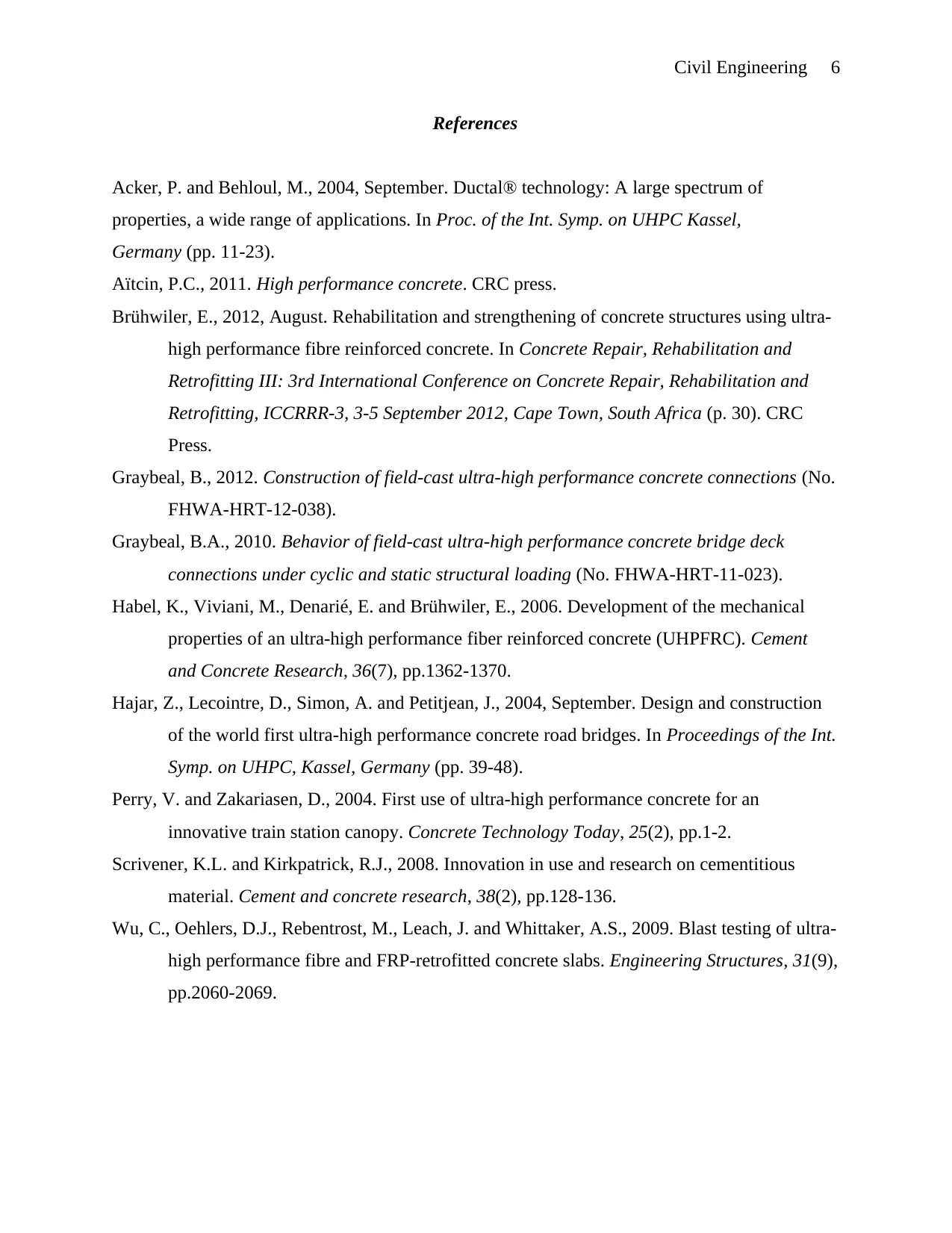
Civil Engineering 6
References
Acker, P. and Behloul, M., 2004, September. Ductal® technology: A large spectrum of
properties, a wide range of applications. In Proc. of the Int. Symp. on UHPC Kassel,
Germany (pp. 11-23).
Aïtcin, P.C., 2011. High performance concrete. CRC press.
Brühwiler, E., 2012, August. Rehabilitation and strengthening of concrete structures using ultra-
high performance fibre reinforced concrete. In Concrete Repair, Rehabilitation and
Retrofitting III: 3rd International Conference on Concrete Repair, Rehabilitation and
Retrofitting, ICCRRR-3, 3-5 September 2012, Cape Town, South Africa (p. 30). CRC
Press.
Graybeal, B., 2012. Construction of field-cast ultra-high performance concrete connections (No.
FHWA-HRT-12-038).
Graybeal, B.A., 2010. Behavior of field-cast ultra-high performance concrete bridge deck
connections under cyclic and static structural loading (No. FHWA-HRT-11-023).
Habel, K., Viviani, M., Denarié, E. and Brühwiler, E., 2006. Development of the mechanical
properties of an ultra-high performance fiber reinforced concrete (UHPFRC). Cement
and Concrete Research, 36(7), pp.1362-1370.
Hajar, Z., Lecointre, D., Simon, A. and Petitjean, J., 2004, September. Design and construction
of the world first ultra-high performance concrete road bridges. In Proceedings of the Int.
Symp. on UHPC, Kassel, Germany (pp. 39-48).
Perry, V. and Zakariasen, D., 2004. First use of ultra-high performance concrete for an
innovative train station canopy. Concrete Technology Today, 25(2), pp.1-2.
Scrivener, K.L. and Kirkpatrick, R.J., 2008. Innovation in use and research on cementitious
material. Cement and concrete research, 38(2), pp.128-136.
Wu, C., Oehlers, D.J., Rebentrost, M., Leach, J. and Whittaker, A.S., 2009. Blast testing of ultra-
high performance fibre and FRP-retrofitted concrete slabs. Engineering Structures, 31(9),
pp.2060-2069.
References
Acker, P. and Behloul, M., 2004, September. Ductal® technology: A large spectrum of
properties, a wide range of applications. In Proc. of the Int. Symp. on UHPC Kassel,
Germany (pp. 11-23).
Aïtcin, P.C., 2011. High performance concrete. CRC press.
Brühwiler, E., 2012, August. Rehabilitation and strengthening of concrete structures using ultra-
high performance fibre reinforced concrete. In Concrete Repair, Rehabilitation and
Retrofitting III: 3rd International Conference on Concrete Repair, Rehabilitation and
Retrofitting, ICCRRR-3, 3-5 September 2012, Cape Town, South Africa (p. 30). CRC
Press.
Graybeal, B., 2012. Construction of field-cast ultra-high performance concrete connections (No.
FHWA-HRT-12-038).
Graybeal, B.A., 2010. Behavior of field-cast ultra-high performance concrete bridge deck
connections under cyclic and static structural loading (No. FHWA-HRT-11-023).
Habel, K., Viviani, M., Denarié, E. and Brühwiler, E., 2006. Development of the mechanical
properties of an ultra-high performance fiber reinforced concrete (UHPFRC). Cement
and Concrete Research, 36(7), pp.1362-1370.
Hajar, Z., Lecointre, D., Simon, A. and Petitjean, J., 2004, September. Design and construction
of the world first ultra-high performance concrete road bridges. In Proceedings of the Int.
Symp. on UHPC, Kassel, Germany (pp. 39-48).
Perry, V. and Zakariasen, D., 2004. First use of ultra-high performance concrete for an
innovative train station canopy. Concrete Technology Today, 25(2), pp.1-2.
Scrivener, K.L. and Kirkpatrick, R.J., 2008. Innovation in use and research on cementitious
material. Cement and concrete research, 38(2), pp.128-136.
Wu, C., Oehlers, D.J., Rebentrost, M., Leach, J. and Whittaker, A.S., 2009. Blast testing of ultra-
high performance fibre and FRP-retrofitted concrete slabs. Engineering Structures, 31(9),
pp.2060-2069.
⊘ This is a preview!⊘
Do you want full access?
Subscribe today to unlock all pages.

Trusted by 1+ million students worldwide
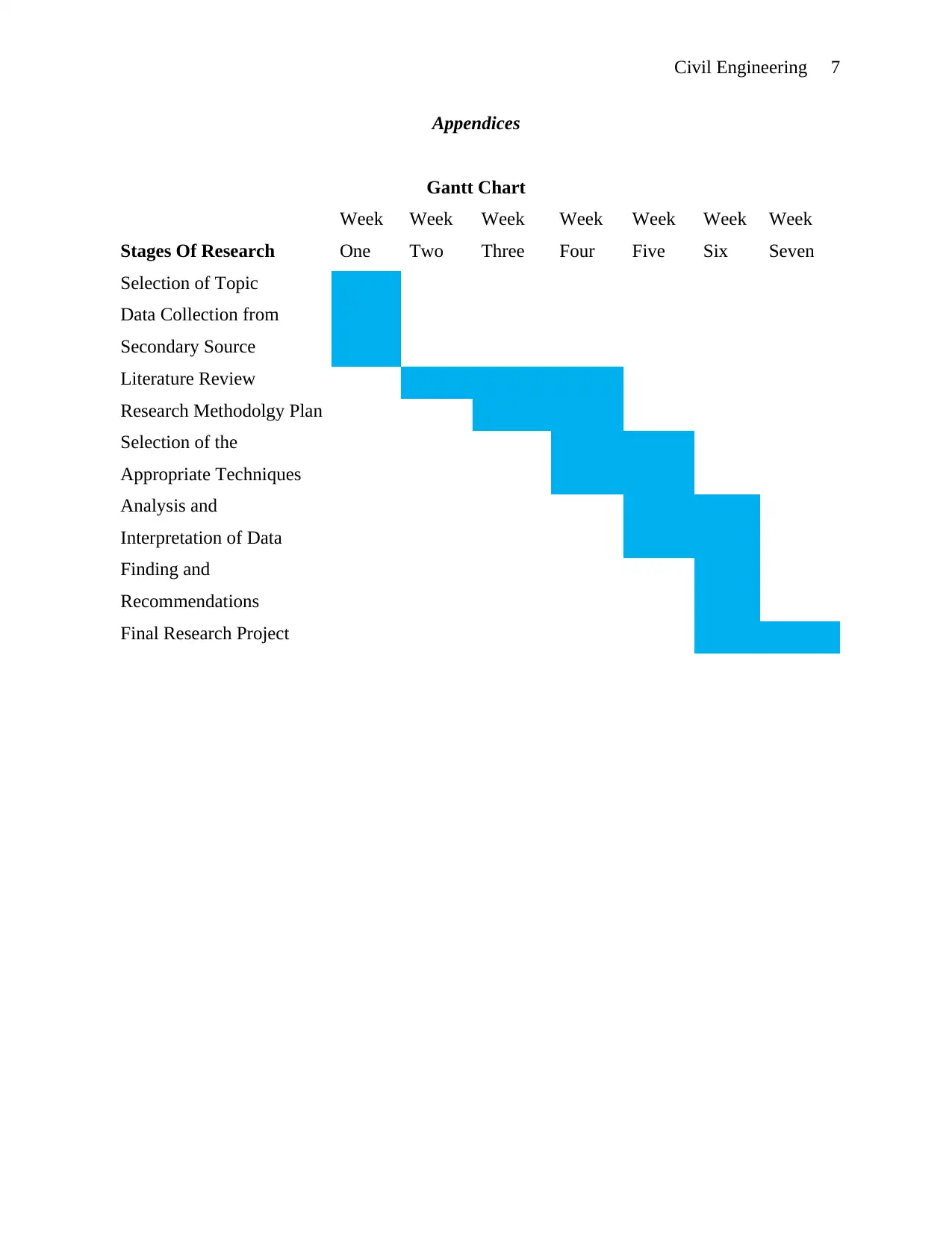
Civil Engineering 7
Appendices
Gantt Chart
Stages Of Research
Week
One
Week
Two
Week
Three
Week
Four
Week
Five
Week
Six
Week
Seven
Selection of Topic
Data Collection from
Secondary Source
Literature Review
Research Methodolgy Plan
Selection of the
Appropriate Techniques
Analysis and
Interpretation of Data
Finding and
Recommendations
Final Research Project
Appendices
Gantt Chart
Stages Of Research
Week
One
Week
Two
Week
Three
Week
Four
Week
Five
Week
Six
Week
Seven
Selection of Topic
Data Collection from
Secondary Source
Literature Review
Research Methodolgy Plan
Selection of the
Appropriate Techniques
Analysis and
Interpretation of Data
Finding and
Recommendations
Final Research Project
1 out of 10
Related Documents
Your All-in-One AI-Powered Toolkit for Academic Success.
+13062052269
info@desklib.com
Available 24*7 on WhatsApp / Email
![[object Object]](/_next/static/media/star-bottom.7253800d.svg)
Unlock your academic potential
Copyright © 2020–2025 A2Z Services. All Rights Reserved. Developed and managed by ZUCOL.





